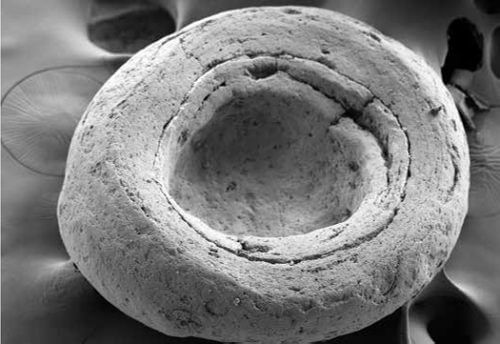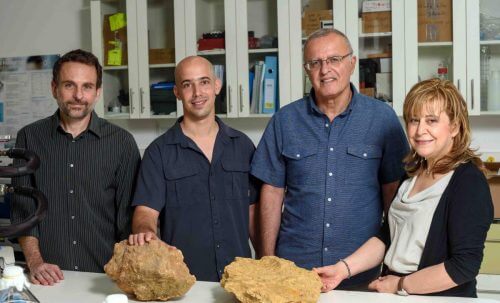The researchers concluded that the theory according to which the ancient ocean was hot - close to the boiling point - with far-reaching consequences for ancient life forms and climatic feedback mechanisms, is incorrect

During transitional seasons, the weather forecasters usually report the height of the sea waves and the temperature of the water - for the benefit of the surfers (who are interested in high waves) on the one hand, and the swimmers (who are interested in low waves and relatively warm water) on the other hand. The "conflict of interest" between these two communities is somewhat reminiscent of a debate that has been going on for many years between scientists, regarding the properties of the ancient ocean on Earth. In short, the question at hand can be formulated as follows: Was the ancient ocean water very hot (about 70 degrees Celsius or more), while the isotopic composition of the oxygen in the water was similar to the composition we know today? Or maybe the ancient ocean was characterized by a temperature similar to the average value today (with a variation of up to 20 degrees Celsius), alongside a more significant difference in the isotopic composition of the oxygen in the water, compared to the composition we know today?
In this context, when it comes to the isotopic composition, it means the quantitative ratio between the common isotope of oxygen, oxygen 16, and the heavier and rarer isotope, oxygen 18.

Nir Galili, a research student from Prof. Itai Halevi's group, from the Department of Earth and Planetary Sciences at the Weizmann Institute of Science, tackled this question, the solution of which may provide important information about the conditions that prevailed on the early Earth in the first stages of animal evolution, and To help understand the mechanisms of regulation and change of the world's climate. In an article published by the scientists in the scientific journal Science, they describe how they used small, layered grains ("eoids") made of iron oxides to examine this question. The isotopic composition of the oxygen in the eoids was measured in partnership with Prof. Aldo Shemesh and Dr. Ruth Yam from his group, also from the Institute, whose expertise in accurate isotopic measurements of tiny samples made it possible to build the database necessary to solve the question. The distribution of oxygen isotopes in the eoids indicates the isotopic composition of the oxygen that was in the ocean when they were formed. In this sense, they can be seen as a kind of "oceanic time capsules". Thus, when eoids are collected from dozens of places around the world, from layers formed at different times in the history of the earth (in this study, the scientists collected samples up to two billion years old), the chemical and isotopic picture of the ancient ocean is obtained.
"We collected two types of iron oxides that formed in the ancient ocean," says Prof. Halevi, "goethite and hematite. But in order to learn from the isotopic composition of that of the ancient ocean, we needed a calibration." To this end, the members of the group synthesized these oxides in the laboratory, thus making an experimental connection between the isotopic composition of the oxides and the composition of the water from which they were formed. "We developed and tested methods for measuring the isotopic composition of minute amounts of iron oxides," says Prof. Shemesh, "which we had not analyzed before." By combining the results of the calibration and the composition of the eoids, the researchers deciphered the isotopic composition of the water of the ancient oceans over the past two billion years.
When aeoids are collected from dozens of places around the world, from layers formed at different times in the history of the earth (in this study, the scientists collected samples up to two billion years old), the chemical and isotopic picture of the ancient ocean is obtained."
An iron oxide aoid collected from an abandoned iron mine near Menara Cliff. An oceanic time capsule
In this way, the scientists were able to show that the earlier the period, the lower the relative share of the heavy oxygen isotope (oxygen 18), compared to its lighter brother (oxygen 16). In other words, we can say that as time passed since the formation of the first oceans, the seawater contained more and more heavy isotopes of oxygen. "Indeed," says Prof. Halevi, "it is a difference of only 2-1%, but this change is enough for us to understand that the theory according to which the ancient ocean was hot - close to the boiling point - with far-reaching consequences for ancient life formations and climatic feedback mechanisms , is not correct".
During most of Earth's history, the average ocean temperature hovered around 20-15 degrees Celsius.
More of the topic in Hayadan:

7 תגובות
72% of the country is sea, which means level (hence the level of the seas). Water is one of the elements of nature, meaning a fundamental law in nature says that water will always descend to the lowest point and as soon as it has a boundary, the surface of the water will always be level. Hence, it must be a flat and level land. A ship anchored in Israel, Italy, a beach East West Sea China Japan Everyone at the launch point in the water must be at the same height because of the sea level so how exactly is the Earth I can't figure it out it doesn't contradict a law in nature? This is unthinkable
very interesting. The results of the research will surely affect the field of syntheses that are looking for the origin of the ancient molecule.
Nir Galili was a student of mine and he is a serious and intelligent guy
Lucky that they included Yam as a sun for research
Stunning
When the Earth was formed it was all hot gas that gradually cooled until it became a hot liquid and therefore all the water on its surface was also hot and cooled to its current state. Even today, the earth's crust, which is about 40 km thick, emits hot lava from the many volcanoes on its surface, and in this way it continues to cool.
The article is very interesting and innovative. One of the issues that worries me is that if different rocks such as limestone and limestone show the same change over time, maybe it's a mechanism that science just doesn't understand yet